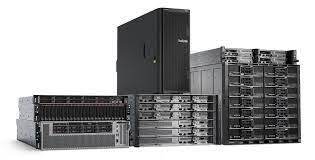7 Reasons Why Rack Servers Still Rule the Data Centre
Rack servers form the backbone of most large enterprise data centres. As the name implies, they are designed to be stacked vertically in standard 19-inch rack cabinets, allowing for extreme density and efficient use of space. Each rack unit, or “U,” is 1.75 inches high. Typical 1U or 2U rack servers can support between 1 and 4 processor sockets and a variety of internal expansion options and drive bays. Their compact design makes them ideal for large-scale virtualization and cloud deployments.
When it comes to reliability and efficiency in the data centre, racks are still hard to beat.
Let’s take a look at 7 reasons why rack servers continue to dominate enterprise IT by scrolling below.
1. Reliability is Job One for the Data Centre.
Reliability is the number one priority in the data centre, and rack servers provide the stability and redundancy needed for truly mission-critical applications. Their rugged metal frames protect components from damage, and hot-swap redundant power supplies and fans minimise downtime from component failures. Large centralised data centres have SLA’s to maintain, and racks help deliver the rock-solid uptime required without breaking the bank.
2. Easy Serviceability and Manageability
Being able to service your servers with minimal disruption is crucial in a large data centre environment. With rack servers, you’ll find them incredibly easy to work on compared to other form factors.
-
Hot Swappable
Let’s start with hot-swapping components. Most racks allow you to pull out a drive, power supply, or fan without shutting down the server or affecting other units stacked in the rack. How convenient is that? There is no need to schedule an extended maintenance window. Just release the failed part, slide in the replacement, and you’re back up and running in minutes.
-
No Unnecessary Tools
This brings us to their tool-less design. Racks famously use screwless slide rails that retract and extend hassle-free. No wrestling with tiny rack screws when you’ve got big hands. Plus, most components simply snap into slots, so even swapping things like RAM or add-in cards is a cinch. You’ll spend less time fighting with hardware and more time actually fixing issues.
-
Easy to Navigate
Their front-access layout means you don’t need to pull a heavy chassis. No balancing on a ladder at the back of the rack or contorting in tiny switched rows. Everything sits right at the front on slides. Combined with great internal space and component labelling, racks are a dream to navigate hands-on.
-
Out-of-Band Capabilities
But what about managing dozens or hundreds of these units remotely? Rack servers truly shine here with robust out-of-band capabilities. Nearly all support remote KVM, media, and storage. This lets you view servers virtually, reboot remotely, and deploy OSes and fixes seamlessly from your desktop. Integrated IPMI also provides real-time environmental and hardware monitoring without logging directly into each host.
-
Live Alerts
Notification alerts keep you informed of anomalies before they escalate. Want to configure hundreds of rack policies or apply a BIOS setting en masse? Advanced RPCM tools got you covered. Their ability to mass deploy and configure operating environments unifies large clusters and streamlines changes across distributed sites.
When disaster strikes and you’ve got dozens of critical issues to resolve, rack manageability helps you triage and remedy them quickly. Swap that bad board immediately without flying anywhere. Plastic chassis, you’ll be kicking yourselves, but not with robust rack infrastructure at your fingertips.
3. Flexible and Scalable Compute
Whether you need additional storage, memory, processors, or expansion cards, rack servers provide flexible scalability. Simply add or swap components as your needs evolve over time. Scaling out racks is less complex than blade extensions, too. Just add another fully redundant unit with all required components modularly included. Racks also allow a level of best-of-breed flexibility that can be difficult to achieve with integrated hyperconverged or appliance-style designs.
4. Rack Servers Dominate Hyperscale Workloads
The largest public cloud providers—who handle literally petabytes of data every hour—overwhelmingly choose rack servers for their scale and flexibility. Hyperscale workloads and webscale computing demand fast, simple expansion combined with best-of-breed components. It’s no coincidence that Facebook, Google, Microsoft, and AWS data centres feature endless aisles of racks over other form factors. Their scale and longevity are simply unparalleled.
5. Lower TCO Over Time
While the up-front cost of a single rack server might be higher than hyperconverged or appliance alternatives, they have proven they can maintain a lower total cost of ownership over a 5–10 year lifespan. Racks retain their resale value extremely well, and components like drives and memory may be refurbished or resold when you upgrade. With some wise investments in things like SSD caching and high-core-count CPUs, older rack gear stays competitive for many secondary workloads too. That translates to a lower average spend on compute cycles over the long term.
6. No Vendor Lock-In Risks
Proprietary form factors for things like blades, hyperconverged nodes, and appliances inevitably come with vendor lock-in risks down the road. But rack standards ensure choice and interoperability. Avoid being tied to a single vendor’s product lifecycles or forced upgrades. Mixing best-of-breed components and having the flexibility to migrate away from any vendor is hugely valuable for large enterprises and service providers with massive infrastructures. Standard racks let decision-making stay focused on needs, not contracts.
7. High Resale and Used Market Value
As mentioned, rack servers retain their value exceptionally well thanks to market saturation and the interchangeability of parts. Redeploy or sell 3-5-year-old rack units to recover 50% or more of their initial cost. Then use those funds to continually refresh with newer units sporting denser features. A robust global market for used rack gear also provides flexibility to rotate assets to the right size over time. The same can’t always be said for proprietary appliances with more limited secondary demand.
Final Words
When reliability, flexibility, scalability, and lower long-term costs matter most, rack servers will continue to rule large-scale data centre operations. Their enduring design has powered the world’s most mission-critical infrastructure for decades. So if your priority is building an IT environment that delivers rock-solid uptime for many years while avoiding vendor risk, standard racks remain the clear choice to meet demanding data centre computing needs both now and into the future.
Read More: How To Unleash Cloud Computing’s Agility



